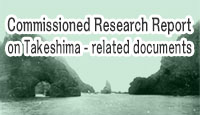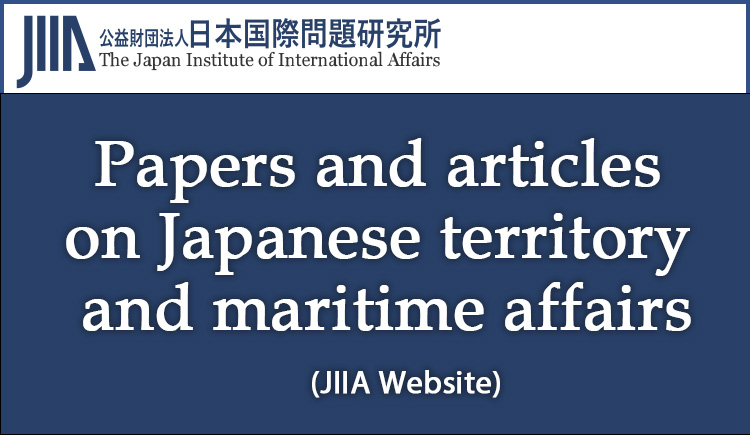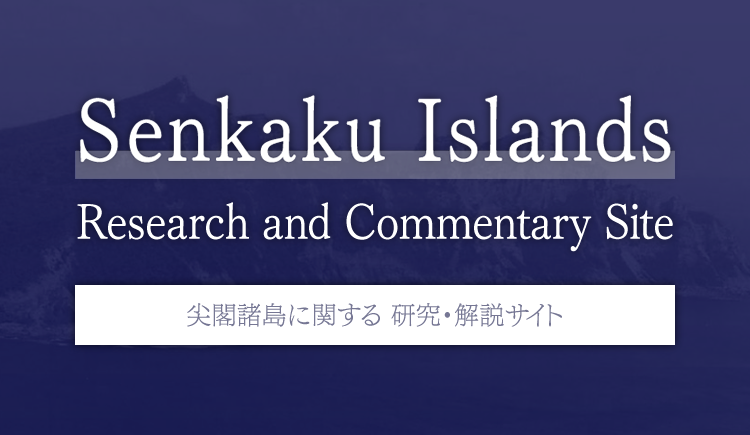The documents and materials published on this website were collected, researched, and prepared with advice from experts, as a part of a Government-commissioned project. The contents of this website do not reflect the views of the Government.
Comprehensive issues
Column Legal Nature of the 1905 Measures to Incorporate Takeshima into Shimane Prefecture of Japan
Tetsuya Nakano (Kansai University)
*Adobe Acrobat Reader DC, provided by Adobe, is needed to view the PDF files. If you do not have the software, please download it from the linked site. Adobe Acrobat Reader DC
1. Introduction
On January 28, 1905 the following Cabinet decision was issued by the Japanese government.
“As regards the attached proposal from the Minister of Home Affairs on the matter of the jurisdiction over an uninhabited island (omitted)…, it is clear from the related documents that this person, named Yozaburo NAKAI, since 1903, has moved to the island and engaged in fishery activities. We recognize the fact of its occupation under international law, and therefore we consider that there would be no obstacle to regard the island as belonging to Japan and to bring it under the jurisdiction of the Director of the Oki Islands branch office of the Shimane Prefectural Government.”1
The Minister of Home Affairs then issued an instruction to the Governor of Shimane Prefecture,
based on the above Cabinet decision, that, “[the islands] are hereby named ‘Takeshima,’ and shall come
under the jurisdiction of the Director of the Oki Islands branch office of the Shimane Prefecture.
You are instructed to proclaim this matter in your jurisdiction.”2 Then, on February 22, 1905, the Governor of Shimane
Prefecture issued the same instruction to Oki Island branch office,3
and also released a prefecture-wide notice to the effect that Takeshima would become a part of the
prefecture, under the jurisdiction of the Director of Oki Islanda branch office.4 On February 24, the San-in Shimbun and Shoyo Shimpo newspapers
reported on this notice, under the respective headlines, “New Oki Islands,” and “Takeshima Newly Come
Under Shimane Prefecture Jurisdiction.”5
The Japanese government considers that, with the above-mentioned Cabinet decision, it “reaffirmed its sovereignty over Takeshima.”6 Accordingly, the Cabinet decision “does not indicate or imply that prior to [the Cabinet decision] Japan did not hold sovereignty over Takeshima, or that sovereignty was held by some other State,” and what is more, the subsequent measures that were taken to incorporate Takeshima were “also published in the newspapers of the day, and were implemented effectively, without any recourse to clandestine measures.”7 In response, the government of the Republic of Korea (ROK) asserts that, “To state that Japan reaffirmed its sovereignty over its own territory is an impossible defense under international law and one for which there is no precedent.”8 In addition, the ROK government contends that the fact an attempt was made to incorporate Dokdo by an official notice issued by Shimane Prefecture indicates that the “Japanese Government consistently acknowledged that Dokdo was non-Japanese territory.”9 In any event, the ROK government asserts that the stipulations of Imperial Edict No. 41, which was issued in 1900, “clearly demonstrate the fact that…[Korea] had continued to govern Dokdo and exercised Korea’s sovereignty over Dokdo.” What is more, the measure by Japan to incorporate the islands “was not only an illegal act that infringed upon Korea’s long-standing and undeniable sovereignty over the island, but also null and void under international law.”10 In addition, the ROK government argues that “The notice issued by Shimane Prefecture is nothing more than a notice from a provincial government, and it was not notified to the government of Korea at the time through official diplomatic procedures. What is more, as it was issued secretly, not even normal Japanese citizens, let alone other countries, were aware of its content. Accordingly, it can in no way be regarded as a public announcement of a nation’s intentions.”11
As can be seen from the above, the two countries’ claims relating to the Cabinet decision and subsequent incorporation measures are diametrically opposed. However, the ROK’s claims have absolutely no basis in international law. The purpose of this paper is to demonstrate this point. To do so, it would be advisable to first take a look at the background leading to the Cabinet decision.
Note 1
“The uninhabited island, located 85 nautical miles northwest of Oki Island, would be named Takeshima and it would come under the jurisdiction of the Head of the Oki Island branch office of Shimane Prefecture.” A digitized sample of the original document can be viewed here on Takeshima Archives Portal.
Note 2
“Instruction No. 87.” A digitized sample of the original document can be viewed here on Takeshima Archives Portal.
Note 3
“Shimane Prefecture General Affairs No. 11.” A digitized sample of the original document can be viewed here on Takeshima Archives Portal.
Note 4
“Shimane Prefectural Notice No. 40.” A digitized sample of the original document can be viewed here on Takeshima Archives Portal.
Note 5
“New Oki Islands” (San-in Shimbun). A digitized sample of the original document can be
viewed here on Takeshima Archives Portal.
“Takeshima Islands Newly Come Under Shimane Prefecture Jurisdiction” (Shoyo Shimpo). A digitized sample
of the original document can be viewed here on Takeshima Archives Portal.
Note 6
Ministry of Foreign Affairs of Japan, “Japanese Territory: Incorporation of Takeshima into Shimane Prefecture; 2.” Available to view here.
Note 7
“View of the Government of Japan Concerning Takeshima,” July 13, 1953. Tsukamoto Takashi, “Views of the Japanese and Korean Governments on Territorial Rights over Takeshima,” The Reference, (National Diet Library, June 2002 Edition; hereafter cited as “Tsukamoto, The Reference”), p. 60.
Note 8
Northeast Asian History Foundation, “Rebuttal to Assertions made by the Ministry of Foreign Affairs of Japan Concerning the Sovereignty of Dokdo,” p. 11. The document is available on the website of the ROK Embassy in Japan.
Note 9
Ministry of Foreign Affairs, ROK, “Dokdo: Beautiful Island of Korea” pamphlet, p. 8. Available to download here.
Note 10
Ibid., pp. 8-9.
Note 11
“Rebuttal by the Government of Korea to the View of the Government of Japan Concerning Takeshima dated July 13, 1953,” September 9, 1953. Tsukamoto, The Reference (supra note 7), pp. 60-61.
2. Background leading to the Cabinet decision
Yozaburo NAKAI was from Ogamo Village, Tohaku County in Tottori Prefecture and resided in Saigo Town, Suki County in the Oki Islands at the time of his request for the lease of Takeshima. From 1903, he invested his own funds in setting up a fishing hut on Takeshima, which was referred to at that time as the “Lyanko Islands,” and in hunting sea lions there. Although he initially incurr ed tremendous losses, from 1904 onwards, prospects for business started to improve. However, given that it looked as if the business would be viable, many other people started their own sea lion hunting operations, leading to a crash in the sea lion population around Takeshima due to over-hunting. It was in response to this situation that NAKAI devised a plan to eliminate competition and establish a monopoly for his business. He travelled to Tokyo on September 29, 1904, where he submitted an application to lease Takeshima in its entirety.12 NAKAI’s petition was successful and he received a response from officials responsible at the Ministry of Foreign Affairs to the effect that “incorporation of the islands should be expedited.”13 Upon receiving a request from the Ministry of Foreign Affairs, the Meiji government decided to collect opinions from Shimane prefectural government. The Shimane government in turn sought the opinion of the Director of the Oki Islands branch office,14 who indicated that he had no objection to Takeshima being incorporated under the jurisdiction of the Oki Island branch office.15 The Shimane government reported this back to Tokyo, and the proposal as tabled by the Minister of Home Affairs was duly approved by the Cabinet.
Note 12
“Request for incorporation into the territory and lease of Lyanko Islands.” A digitized
sample of the original document can be viewed here on Takeshima Archives Portal.
Tamura Seizaburo, New Research on
Takeshima, Shimane Prefecture (reprinted and revised edition), pp. 40-43.
Note 13
For details on the background to this decision see Okuhara Hekiun, Takeshima and Utsuryo Island (Reprinted edition), (Harvest Publishing), pp. 55-56; and Naito Seichu and Kim Byeong-Ryeol, Historical Verification of Takeshima/Dokdo, (Iwanami Shoten, 2007), p. 84.
Note 14
“General Affairs No. 1073,” A digitized sample of the original document can be viewed here on Takeshima Archives Portal.
Note 15
Naito Seichu, “Issues Surrounding Japan’s Incorporation of Takeshima,” Study of Cultures in Northeast Asia, Vol. 24 (2006), p. 13.
Takeshima
Research and Commentary Site
- I Comprehensive issues
- II Commentary on themes by historical period
- III Analysis of claims by other countries





